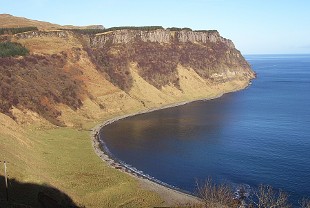Local people on Skye are being invited to become voluntary wardens to help safeguard vulnerable fossil sites in a bid to tackle the problem of reckless collecting.
Skye is known as the ‘dinosaur isle’ due to its rich heritage of fossil sites, particularly from the Jurassic period, around 200 million years ago to 145 million years ago.
And though most people follow Scotland’s Fossil Code, there are still examples of people damaging these sites by collecting fossils in an irresponsible and therefore unacceptable way.
A public meeting tonight Tuesday (20 May) will be held at Tigh na Sgire, Portree, at 7pm involving Scottish Natural Heritage (SNH) The Highland Council, National Museums Scotland and The Hunterian Museum.
It is hoped that a system will be developed to rescue, record and safeguard important fossils found on the island’s beaches. There will also be a call for the promotion of the islands’ fossil heritage as part of a tourism initiative to help boost the local economy.
Skye and Raasay have a rich geological heritage spanning the last three billion years of Earth’s history. Fossil remains of plants and animals record the evolution of life . They also record the fascinating journey of the area we now know as Skye and Raasay, as it drifted for hundreds of millions of years across the face of the Earth.
Scotland’s Fossil Code, the first truly national code of its kind, has offered best practice and guidance in the collecting and care of fossils since it was published in 2008.
SNH geologist Dr Colin MacFadyen said: “Skye and Raasay have a fantastic fossil heritage, and kids and amateur fossil hunters should be encouraged to collect.
“But at the same time something has to be done about irresponsible collecting and to reduce examples where people for whatever reasons damage fossil localities and important fossils. This is where the local community can get involved and help secure their threatened natural heritage. Local action may ensure that rare fossil finds are rescued, recorded and saved for the nation.
“The public meeting in Portree will encourage local people to play an important part in safeguarding and promoting an internationally significant asset.”
Dr Nick Fraser, Keeper of Natural Sciences at National Museums Scotland said: “We are excited by the opportunities to work together to bring Skye’s remarkable fossil heritage into greater prominence. This is a precious resource which, with support from the wider community, will benefit generations of islanders.”
Dr Neil Clark of the Hunterian Museum at the University of Glasgow said: “Skye has internationally important fossils including the very rare dinosaur remains which have only been found there since 1982. Skye is the only place in Scotland from which dinosaurs have been found and has more than 10% of the World’s Middle Jurassic dinosaur species and more than 15% of the Middle Jurassic dinosaur sites. It is important that we look after and properly document these rare and globally significant fossil remains for future generations to study and enjoy.”
The event called Skye’s Fossil Heritage will include an expert-led visit to look at fossils and possibly take in the An Corran dinosaur footprints.
It will focus on fossil collecting; safeguarding vulnerable fossil localities; using Skye’s fossil heritage to benefit the island economy, and establishing a ‘Dinosaur Island Promotion and Fossil Safeguard Group.’

